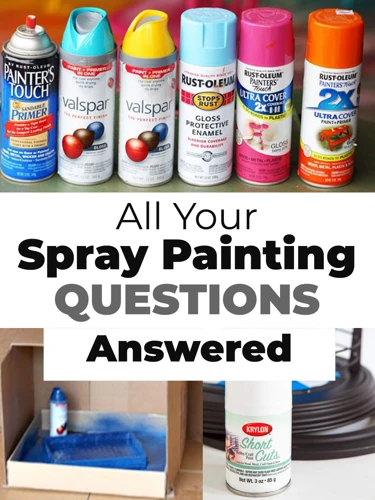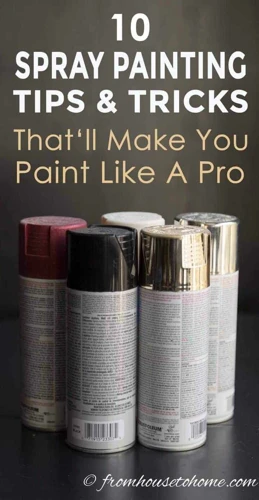Embracing the world of DIY paint sprayer techniques can transform the way you approach home improvement tasks. From refreshing your living room walls to rejuvenating furniture, mastering the art of spray painting DIY is both a time-saver and a way to achieve a professional finish. In this comprehensive guide, we’ll explore everything from the paint spraying basics to advanced painting techniques, ensuring your DIY home painting projects stand out with a flawless finish.
Choosing the Right DIY Paint Sprayer
Homemade Paint Sprayer Options
When it comes to creating a homemade paint sprayer, resourceful DIYers may consider converting garden sprayers or other household items. While these can be budget-friendly alternatives, it’s important to weigh their effectiveness for your specific project needs against the benefits of commercially available sprayers.
Pros and Cons of Different Sprayer Models
Selecting the right DIY paint sprayer from the market involves understanding the pros and cons of various models. From handheld units to more robust, professional-grade options, consider factors such as capacity, power source, and ease of use to find the sprayer that aligns with your project’s scope and complexity.
Paint Spraying Basics for Beginners
Understanding Paint Sprayer Components
Before diving into your first project, familiarize yourself with the key components of a paint sprayer. The nozzle, paint cup, and adjustable settings are crucial for controlling the flow and pattern of your spray, making them integral to achieving a smooth finish.
Setting Up Your Paint Sprayer
Setting up your paint sprayer correctly is the first step to success. Begin by thoroughly reading the manufacturer’s instructions, assembling the sprayer, and performing a test run on a piece of cardboard to get comfortable with the controls and flow rate.
How to Use a Paint Sprayer
Preparation and Safety Tips
Prior to starting your spray painting DIY session, ensure the area is well-ventilated and you’re wearing appropriate safety gear, such as a mask and goggles. Cover any nearby surfaces to protect them from overspray, and always keep the sprayer moving to avoid drips and runs.
Paint Sprayer Tutorial: Step-by-Step Guide
- Prepare the surface you’re painting by cleaning and sanding if necessary.
- Protect the surrounding area with drop cloths and painter’s tape.
- Fill your sprayer with paint, following any thinning guidelines provided.
- Adjust the sprayer settings for the desired spray pattern and thickness.
- Hold the sprayer at a consistent distance and angle from the surface.
- Apply the paint in smooth, overlapping strokes for even coverage.
DIY Spray Paint Projects: Getting Started
Start with small DIY spray paint projects to build your confidence. Items like picture frames or plant pots are perfect for practicing your technique and experimenting with colors and finishes.
Advanced Painting Techniques with a Sprayer
Techniques for Even Coverage
To achieve even coverage when using your DIY paint sprayer, maintain a consistent speed and distance from the surface. Overlap each pass by about 50% and keep the sprayer perpendicular to avoid angled spray, which can cause uneven layers.
Managing Overspray and Drips
Controlling overspray requires careful masking of adjacent areas and choosing the right settings on your sprayer for the paint’s viscosity. To prevent drips, avoid lingering in one spot for too long and keep the paint layers thin and uniform.
Special Effects with Spray Paint
With a bit of creativity, your paint sprayer can be used to create a range of special effects. Techniques like layering different colors or using stencils can add depth and texture to your projects, making them truly unique.
DIY Home Painting: Room by Room Guide
Interior Walls and Ceilings
For interior walls and ceilings, a DIY paint sprayer can help you cover large areas quickly and with less effort than traditional rollers. Start at the top and work your way down, applying consistent pressure for a uniform finish.
Exterior Surfaces and Outdoor Projects
Exterior surfaces require a paint sprayer with more power and durability. When tackling outdoor projects, consider the type of paint and primer needed for different materials like wood, metal, or masonry to ensure longevity and resistance to the elements.
Paint Sprayer Tips for a Professional Finish
How to Maintain Consistent Pressure
Maintaining consistent pressure is key to a professional finish. This ensures a steady flow of paint and reduces the chances of sputtering or uneven application. Check your sprayer’s manual for guidance on optimal pressure settings.
Mastering the Spray Pattern and Technique
Mastering the spray pattern and technique takes practice. Begin with a narrow pattern for detailed work and a wider pattern for large surfaces. Keep your wrist steady and use your entire arm to guide the sprayer for the best results.
Troubleshooting Common Paint Sprayer Issues
Dealing with Clogs and Blockages
Clogs and blockages can occur when debris enters the nozzle or when paint dries inside the sprayer. To resolve this, disassemble the nozzle and clean it with an appropriate solvent. Always strain your paint before use to minimize clogging.
Fixing Uneven Spray and Blotches
Uneven spray patterns and blotches often result from incorrect sprayer settings or technique. Ensure the paint is properly thinned, the nozzle is clean, and that you’re moving the sprayer consistently to rectify these issues.
Paint Sprayer Maintenance and Cleanup
Cleaning Your DIY Paint Sprayer
Proper cleaning is essential after each use to keep your DIY paint sprayer in top condition. Flush the system with water or solvent, disassemble the key components, and clean them thoroughly to prevent residue buildup.
Long-term Storage Solutions
When storing your paint sprayer for extended periods, follow the manufacturer’s guidelines to avoid damage. Lubricate any moving parts and store the sprayer in a dry, dust-free environment to ensure it’s ready for your next DIY home painting project.
Conclusion: Next Level DIY Spray Painting
Reflecting on What You’ve Learned
Reflecting on the painting techniques and paint sprayer tips you’ve learned, you can now tackle an array of DIY spray paint projects with confidence. With practice, you’ll see your skills improve, leading to more sophisticated and polished results.
Are you looking to give your furniture a fresh, new look? DIY spray painting can be a fun and satisfying project! For a comprehensive guide on how to spray paint furniture, check out our article on DIY spray painting furniture. If you encounter any hiccups along the way, our troubleshooting tips at paint sprayer troubleshooting can help you solve common issues. And to make an informed decision on the best tools for your project, don’t miss our comparison of paint sprayers versus rollers. Happy painting!
Exploring Further DIY Spray Paint Projects
As you become more adept with your DIY paint sprayer, the possibilities for home improvement and creative expression are endless. From repurposing furniture to adding curb appeal to your home’s exterior, the journey of exploring further DIY spray paint projects is both rewarding and enjoyable.




